« Amorino (Antonio Canova) » : différence entre les versions
m |
Catégories de lieux d'exposition + corrections typographiques |
||
| Ligne 20 : | Ligne 20 : | ||
==L’Amorino Lubomirski== | ==L’Amorino Lubomirski== | ||
La princesse maréchale Izabela Lubomirska (1736 – 1816) dut insister pour que Canova réalise un portrait de son protégé, le jeune prince [[Henryk Lubomirski]]. L’''Amorino Lubomirski'' fut le premier essai de l’artiste dans cette forme particulière de portrait idéalisé, en personnage mythique, une solution | La princesse maréchale Izabela Lubomirska ([[1736]] – [[1816]]) dut insister pour que Canova réalise un portrait de son protégé, le jeune prince [[Henryk Lubomirski]]. L’''Amorino Lubomirski'' fut le premier essai de l’artiste dans cette forme particulière de portrait idéalisé, en personnage mythique, une solution qu’il déclina par la suite dans des portraits de femmes.<ref>Guilhem Scherf dans ''Portraits publics, portraits privés, 1770-1830'', p. 38-39 et note 69.</ref> | ||
Selon une source contemporaine, à cause de la timidité du petit prince, le portrait | Selon une source contemporaine, à cause de la timidité du petit prince qui refusa de poser nu, le portrait s’est limité au visage, et le corps serait inspiré d’exemples antiques [les citer]. Faut-il y voir un défaut dans son éducation rousseauiste, ou au contraire l’expression de sa nature ? Un esprit critique, Alexis von Krüdener (1744 – 1802), a regretté cette entorse à la synthèse néo-classique : | ||
{{Citation bilingue|it|liseré=1|%cit=49|Il rittrato, benchè estremamente armoniosio, non produce un bell’effetto perché è unito a un corpo di bellezza esemplare. Si puo dire che qui coesistano due linguaggie diversi e due verità l’una dall’altra differanziantesi.<ref>Francis Ley, ''Voyage en Italie du baron de Krüdener en 1786'', Paris, Fischbacher, 1983, p. 129, cité dans Anna Coliva et Fernando Mazzocca, ''Canova e la Venere Vincitrice'', Milano, Electa, 2007, ISBN 978-88-370-5589-9, p. 177.</ref>|Le portrait, bien qu’extrêmement harmonieux, ne produit pas un bel effet parce qu’il est uni à un corps d’une beauté exemplaire. L’on peut dire qu’y coexistent deux languages différents, deux vérités différentes l’une de l’autre. | |||
}} | |||
Ce devait être également l’avis de Canova qui, libéré de la contrainte du portrait, a cherché à résoudre ce problème pour ses trois commanditaires ultérieurs anglais, irlandais et russe. Chacune de ces trois autres versions est basée sur le plâtre original (acéphale depuis le bombardement de la gypsothèque de Possagno au cours de la première guerre mondiale). | |||
Une [http://www.zamek-lancut.pl/pl/ZamekDzisiaj/Canova| animation en 3D] se trouve sur le site du palais de | Une [http://www.zamek-lancut.pl/pl/ZamekDzisiaj/Canova| animation en 3D] se trouve sur le site du palais de Łańcut. | ||
{| | {| class="noborder centre cellcentre" width="99%" | ||
|- | |------------------ | ||
| [[Image:CANOVA Antonio 1786 Amorino Lubomirski (Łańcut) (dettaglio 3) 300x447.jpg| | |[[Image:CANOVA Antonio 1786 Amorino Lubomirski (Łańcut) (dettaglio 3) 300x447.jpg|230px|center]] | ||
|[[Image:CANOVA Antonio 1786 Amorino Lubomirski (Łańcut) (dettaglio 1) 1960x2924.jpg|230px|center]] | |||
|[[Image:CANOVA Antonio 1786 Amorino Lubomirski (Łańcut) (dettaglio 2) 300x447.jpg|230px|center]] | |||
|------------------ | |||
|} | |} | ||
La commande date du printemps 1786<ref>Lire Mario Guderzo dans Canova e la Venere Vincitrice, | La commande date du printemps 1786.<ref>Lire Mario Guderzo dans Anna Coliva et Fernando Mazzocca, ''Canova e la Venere Vincitrice'', Milano, Electa, 2007, ISBN 978-88-370-5589-9, p. 171.</ref> « L’insistance importune de la princesse polonaise »<ref>« Dovendo cedere finalmente all’importuna insistenza della principessa polacca Lobromiski (...) ». Livre de comptes d’Antonio Canova, cité par Mario Guderzo dans Anna Coliva et Fernando Mazzocca, ''Canova e la Venere Vincitrice'', Milano, Electa, 2007, ISBN 978-88-370-5589-9, p. 171.</ref> a eu raison des réticences de Canova à sculpter un portrait. | ||
Il a commencé par modeler le visage en terre le 5 juin, a continué | Il a commencé par modeler le visage en terre le 5 juin, puis a continué d’y travailler pendant dix-neuf jours. Le 2 juin, le plâtre était prêt. Le 4 juin, Canova achète à Carlo Albacini, pour la somme de vingt écus, une statue antique pour l’exécution de l’''Amorino''. Le marbre sera expédié à Łańcut en 1790. | ||
En juin 1786, Canova, occupé aux statues du monument au pape Clément XIV pour | En juin 1786, Canova, occupé aux statues du monument au pape Clément XIV pour l’église des Saints-Apôtres, fit une pause pour réaliser le modèle de l’''Amorino Lubomirski''. | ||
A fronte d’ogni sua repugnanza per non aver mai fatto alcun ritratto, dovendo cedere finalmente all’importuna insistenza della principessa polacca Lobromiski, si mise a formare in creta il ritratto d’un leggiadro di lei nipotino di 12 anni, il signor principe Enrico Sartoriski ma per la timidezza sua naturale non pote compierlo se non che da se solo in assenza del giovinetto. Lo modello poscia in aprile sotto la figure intiera d’Amore. (Biblioteca Civica, Bassano del Grappa, manoscritti Canoviani, nr 6022 : Abbozzo di biografia 1804-1805, k.12 vol. (1787), Edizione nazionale, 1994, p. 304 ; Honour, 1994, p. 131.) | |||
‘Adesso (sto?) lavorando o, per meglio dire terminando due Amorini, di grandezza all’età di (dice?) anni uno con la testa ritratto di un Sig.no nepote della Principessa Lubomirski di Varsavia […]’ (Biblioteca Civica, Bassano del Grappa, Manoscritti Canoviani, nr. H-8/6091 : Note di Antonio Canova sulle proprie opere, 1787, k. 1v-2, publié dans ''Edizione nazionale'', 1994, p. 219 ; tez : Costamagna, di Macco, 1973, p. 223). | |||
[[Image:CANOVA Antonio 1786c Ritratto del Principe Henryk Lubomirski come San Giovannino 500x628.jpg|right|thumb|upright=1.5|Attribué à Antonio Canova<br>''Portrait du prince Henryk Lubomirski en petit saint Jean''<br>Huile sur toile, 67 × 53,5 cm<br>Collection privée]] | [[Image:CANOVA Antonio 1786c Ritratto del Principe Henryk Lubomirski come San Giovannino 500x628.jpg|right|thumb|upright=1.5|Attribué à Antonio Canova<br>''Portrait du prince Henryk Lubomirski en petit saint Jean''<br>Huile sur toile, 67 × 53,5 cm<br>Collection privée]] | ||
Cette esquisse peinte à | Cette esquisse peinte à l’huile est attribuée à Canova. Il est tentant à la fois de l’insérer dans le processus de création de l’''Amorino Lubomirski'', et de la faire correspondre à une mention dans la liste des œuvres de Canova (''Mezza figura di fanciullo in atto di guardare un uccello''). Elle était inédite en 2009.<ref>''Canova : l’ideale classico tra scultura e pittura'', Forlì, Musei San Domenico, piazza Guido da Montefeltro, 25 gennaio – 21 giugno 2009 (Comitato scientifico presieduto da Antonio Paolucci. Mostra a cura di Fernando Mazzocca, Sergej Androsov).</ref> | ||
Comitato scientifico presieduto da Antonio Paolucci | |||
Mostra a cura di Fernando Mazzocca, Sergej Androsov </ref> | |||
La princesse maréchale, en plus du marbre, | La princesse maréchale, en plus du marbre, avait demandé deux moulages en plâtre avec feuilles de vigne.<ref>''Italian American Magazine : culture and current affairs : rivista di attualita et cultura'', « Antonio Canova, la bellezza nel marmo ». Article en ligne : [http://www.nycit.it/antonio-canova-la-bellezza-nel-marmo Antonio Canova, la bellezza nel marmo]</ref> L’un d’eux, documenté à Łańcut à partir de 1802, fit partie de la donation de Henryk Lubomirski à l’Ossolineum ; il est retourné à Łańcut après la seconde guerre mondiale. | ||
Trois autres œuvres dérivées sont connues en Pologne. Un buste, qui appartint à la princesse maréchale, une statue entière<ref>Manikowska, 2002, n.XV.25, citée par Mario Guderzo dans Canova e la Venere Vincitrice, | Trois autres œuvres dérivées sont connues en Pologne. Un buste, qui appartint à la princesse maréchale, une statue entière,<ref>Manikowska, 2002, n.XV.25, citée par Mario Guderzo dans Anna Coliva et Fernando Mazzocca, ''Canova e la Venere Vincitrice'', Milano, Electa, 2007, ISBN 978-88-370-5589-9, p. 171.</ref> et une tête entrée vers 1789 dans la collection du roi Stanislas Auguste II Poniatowski.<ref>Correspondance entre Canova et le peintre Marcello Bacciarelli (Mikocka Rachubowa 2003, p. 24-25, citée par Mario Guderzo dans Anna Coliva et Fernando Mazzocca, ''Canova e la Venere Vincitrice'', Milano, Electa, 2007, ISBN 978-88-370-5589-9, p. 171).</ref> | ||
Au palais de Łańcut, la statue fut placée dans le cabinet aux colonnes, dans un décor spécialement remanié pour elle par | Au palais de Łańcut, la statue fut placée dans le cabinet aux colonnes, dans un décor spécialement remanié pour elle par l’architecte néo-classique Szymon Bogumił Zug (1733 – 1807). Un portrait peint du prince Henryk y ornait un trumeau, et fut remplacé par un miroir et un faux-relief en grisaille. Un dessin annoté témoigne de l’interaction entre l’architecte et une princesse très directive.<ref>Reproduit dans Majewska-Maszkowska, 1976, qui justifie : Gab. Ryc. BUW Inw. GR 232 — Zbiór Witke--Jeżewskiego 25. Fot. E. Kozłowska-Tomczyk. Un commentaire en anglais se trouve dans le résumé, p. 608.</ref> | ||
Commentaire | [Commentaire d’Isabella Teotochi Albrizzi] | ||
==L’Amorino Campbell== | ==L’Amorino Campbell== | ||
| Ligne 61 : | Ligne 63 : | ||
[[Image:CANOVA Antonio 1789 Amorino Campbell (Anglesey Abbey) 1307x2843.jpg|right|thumb|upright=1.5|''Amorino Campbell''<br>Abbaye d’Anglesey]] | [[Image:CANOVA Antonio 1789 Amorino Campbell (Anglesey Abbey) 1307x2843.jpg|right|thumb|upright=1.5|''Amorino Campbell''<br>Abbaye d’Anglesey]] | ||
Sculptée en 1788- | Sculptée en 1788-1789 pour le colonel John Campbell, futur premier baron Cawdor (1755 – 1821), qui fut aussi le commanditaire (jamais livré) du groupe ''Psyché et Cupidon'', aujourd’hui au musée du Louvre. | ||
Canova | Canova n’était pas pleinement satisfait de la tête de ce second ''Amorino'' (une version inversée, et légèrement expressive, de la tête de l’''Amour'' de Centocelle), et a proposé à John Campbell de lui en sculpter un autre, s’il parvenait à s’en débarrasser en le vendant au jeune John David La Touche. Des commentaires favorables étaient parvenus à Campbell ; il maintint sa commande et à l’arrivée de son ''Amorino'' à Londres en janvier 1791, se déclara ravi et paya à Canova la somme de cent sequins en plus des cinq cents convenus. | ||
La commmande comprenait un piédestal en forme | La commmande comprenait un piédestal en forme d’autel romain avec une plateforme tournante et un décor sculpté en relief avec des aigles qui suspendent des festons de fleurs dans des bordures de feuillage.<ref>84 cm (33 pouces) de haut. Ce socle a disparu entre 1937 et 1964.<br>The circular pedestal, which was ‘sculptured in relief with eagles suspending festoons of flowers within foliage borders, 33in. high’ (Christie’s 1937 sale catalogue description), and can be seen in a photograph taken of the sculpture when it was in the hall of Torry Hill, was still under the statue when this was sold by D. Leigh Pemberton at Christie’s on 22 July 1937 (lot 20), where it was bought by Mr. and the Hon. Mrs Basil Ionides, but was no longer so when Messrs. Crowther, who had bought the statue from Buxted Place after the death of Mrs Ionides, advertised it in ''Country Life'', 3 December 1964, supplement p. 46 (quaere whether destroyed in the fire that ravaged the house in 1940?). Source http://www.nationaltrustcollections.org.uk/object/516599</ref> | ||
Quatremère de Quincy a mentionné l’''Amorino Campbell'' en 1834.<ref>« ''L’Amour'' dont il est ici question fut le portrait du jeune prince Henri Czartorinski, pour la princesse Lubomirski. La tête du jeune homme étoit digne de devenir celle du fils de Vénus. Canova en fit depuis lors une répétition pour lord Cawdor. » (Quatremère de Quincy, ''Canova et ses ouvrages ou Mémoires historiques sur la vie et les travaux de ce célèbre artiste'', Paris, Adrien Le Clere et Cie, 1834, p. 37.</ref> | |||
{{Clr}} | |||
[[Image:CANOVA Antonio - Amorino Carlo Orsi 1181x1581.jpg|left|thumb|upright=1.5|''Amorino'' exposé par la galerie Carlo Orsi Antichità (Milan)]] | [[Image:CANOVA Antonio - Amorino Carlo Orsi 1181x1581.jpg|left|thumb|upright=1.5|''Amorino'' exposé par la galerie Carlo Orsi Antichità (Milan)]] | ||
Un exemplaire en plâtre de cet Amorino était en 2013 la propriété de l’antiquaire milanais Carlo Orsi Antichità, qui l’a exposé en 2010 au Palais de Venise, à Rome, à l’occasion de la 7{{e}} Biennale Internationale de l’Antiquariat. | Un exemplaire en plâtre de cet ''Amorino'' était en 2013 la propriété de l’antiquaire milanais Carlo Orsi Antichità, qui l’a exposé en 2010 au Palais de Venise, à Rome, à l’occasion de la 7{{e}} Biennale Internationale de l’Antiquariat.<ref>Retravailler cette référence : C. Orsi, 2007 - 55 pages | ||
<br> | |||
p. 25 et 49 | p. 25 et 49 | ||
<br> | |||
In his letter to Canova of 5 July 1789 Zulian wrote: | In his letter to Canova of 5 July 1789 Zulian wrote: “Aveva inteso parlare dell’Amore fatto per un ritratto del figlio della principessa Lubomirski, ma non supeva della replica, che a voluto il colonel Campbell. Avrei desiderato, ma non avrei saputo pregarla del gesso, che cosi […].”</ref> | ||
{{Clr}} | {{Clr}} | ||
==L’Amorino La Touche== | ==L’Amorino La Touche== | ||
| Ligne 80 : | Ligne 82 : | ||
[[Image:CANOVA Antonio 1789 Amorino La Touche (National Gallery of Ireland) 773x1566.jpg|right|thumb|upright=1.5|''Amorino La Touche''<br>National Gallery of Ireland, Dublin]] | [[Image:CANOVA Antonio 1789 Amorino La Touche (National Gallery of Ireland) 773x1566.jpg|right|thumb|upright=1.5|''Amorino La Touche''<br>National Gallery of Ireland, Dublin]] | ||
N° | N° d’inventaire : | ||
Heritage Gift, Bank of Ireland, 1998 | Heritage Gift, Bank of Ireland, 1998 | ||
NGI.8358 | NGI.8358 | ||
Cet Amorino<ref> | Cet Amorino<ref>Sergio Benedetti, ''The La Touche Amorino: Canova and his fashionable Irish patrons'', National Gallery of Ireland, nov. 1998, ISBN 0903162067<br>Hugh Honour, « Canova’s Amorini for John Campbell and John David La Touche », in : ''La scultura : studi in onore di Andrew S. Ciechanowiecki'', Torino, 1994 (Antologia di belle arti, N.S. ; 48-51), p. 129, 139.</ref> fut redécouvert en mauvais état dans un jardin en 1996,<ref>Alan Murdoch in Dublin, « Lost Canova’s return to glory », Monday 9 November 1998. En ligne : [http://www.independent.co.uk/news/lost-canovas-return-to-glory-1183761.html Lost Canova’s return to glory]</ref> et acquis par la Galerie nationale d’Irlande à Dublin avec l’aide de la banque d’Irlande. | ||
Le peintre irlandais Hugh Douglas Hamilton (?-?), ami de Canova, servit | De passage à Rome en 1789, le jeune John David La Touche (1775 – 1820), fils du fondateur de la banque d’Irlande, en avait passé commande à Canova.<ref>S. Benedetti, ''The La Touche Amorino'', Dublin, 1998, p. 18-25, no. 1.</ref> L’''Amorino'' arriva à Dublin en août 1792.<ref>Hugh Douglas Hamilton assista au déballage de l’''Amorino'' à la résidence des La Touche à Dublin, Harcourt Street, le 14 août 1792. Lire F. Cullen, ‘The Oil Paintings of Hugh Douglas Hamilton’, Walpole Society, vol. L, 1984, p. 169-170.</ref> | ||
Le peintre irlandais Hugh Douglas Hamilton (?-?), ami de Canova, servit d’intermédiaire entre Canova et La Touche.<ref>Il fit plusieurs portraits de membres de la famille La Touche. Lire S. Benedetti, ''The La Touche Amorino'', Dublin, 1998, p. 8, et W. G. Strickland, ''A dictionary of Irish artists'', Dublin, London, 1913, vol. I, p. 441.</ref><ref>The extent of Hamilton’s involvement with the La Touche family is evident by the large number of portraits he painted of family members (see S. Benedetti, ''The La Touche Amorino'', Dublin, 1998, p. 8 and W. G. Strickland, A Dictionary of Irish Artists, Dublin and London, 1913, vol. I, p. 441). In fact, Hamilton had been well known to the La Touches since the mid-1760s: he is known to have painted three portraits of John David in oil (a full length portrait is in the collection of the Bank of Ireland); three pastel portraits (one of which is in the National Gallery of Ireland). From 1787 to 1793 La Touche returned to Italy and it was whilst he was in Rome that he sat to Hamilton. In 1789 he commissioned from Canova the Amorino (see S. Benedetti, The La Touche Amorino, Dublin, 1998, p. 18-25, no. 1.) which was finished in 1793. There can be little doubt that it was Hamilton who introduced La Touche to Canova. | |||
The relationship between the two men continued after their respective return to Ireland. Hamilton stayed for several days in August and September 1792 at La Touche’s house, Bellevue, in County Wicklow (see F. Cullen, ‘The Oil Paintings of Hugh Douglas Hamilton’, Walpole Society, vol. L, 1984, p. 170). On 14 August 1792 he was present at the unpacking of Canova’s Amorino at the La Touche home in Harcourt Street, Dublin (Ibid. pp. 169-70). | The relationship between the two men continued after their respective return to Ireland. Hamilton stayed for several days in August and September 1792 at La Touche’s house, Bellevue, in County Wicklow (see F. Cullen, ‘The Oil Paintings of Hugh Douglas Hamilton’, Walpole Society, vol. L, 1984, p. 170). On 14 August 1792 he was present at the unpacking of Canova’s Amorino at the La Touche home in Harcourt Street, Dublin (Ibid. pp. 169-70). | ||
A delay in payment to Canova provoked Hamilton in 1794 to describe John David La Touche as the most indecisive and distracted man of this world (Ibid. p. 170). Nevertheless, two years later they were still enjoying each other’s company as attested to by John David’s record in his diary on 21 May 1796, ‘I dined at Mr. Hamilton’s saw his pictures most exquisite… Miss H aimable (sic)’. Three days later he went again to see Hamilton’s paintings (see N. Figgis and B. Rooney, Irish Paintings in the National Gallery of Ireland, vol. 1, National Gallery of Ireland 2001, p. 186, n.106; information supplied by Anne Crookshank and the Knight of Glin; Dublin, NLI, Pos 6016, Diary of John David La Touche 15 July 1794-29 August 1796).</ref> | A delay in payment to Canova provoked Hamilton in 1794 to describe John David La Touche as the most indecisive and distracted man of this world (Ibid. p. 170). Nevertheless, two years later they were still enjoying each other’s company as attested to by John David’s record in his diary on 21 May 1796, ‘I dined at Mr. Hamilton’s saw his pictures most exquisite… Miss H aimable (sic)’. Three days later he went again to see Hamilton’s paintings (see N. Figgis and B. Rooney, Irish Paintings in the National Gallery of Ireland, vol. 1, National Gallery of Ireland 2001, p. 186, n.106; information supplied by Anne Crookshank and the Knight of Glin; Dublin, NLI, Pos 6016, Diary of John David La Touche 15 July 1794-29 August 1796).</ref> | ||
{{Clr}} | |||
[[Image:CONTI_domenico_portrait_antoniocanovasculptingtheamorinolatouche_ca1793_privatecollectionconti-.jpg|left|thumb|upright=1.5|Domenico Conti<br>''Portrait d’Antonio Canova sculptant l’Amorino La Touche''<br>Vers 1793<br>Collection privée]] | [[Image:CONTI_domenico_portrait_antoniocanovasculptingtheamorinolatouche_ca1793_privatecollectionconti-.jpg|left|thumb|upright=1.5|Domenico Conti<br>''Portrait d’Antonio Canova sculptant l’Amorino La Touche''<br>Vers 1793<br>Collection privée]] | ||
Dans ce portrait | Dans ce portrait d’Antonio Canova dans son atelier, l’''Amorino La Touche'' tient une flèche, qui n’apparaît dans aucune des quatre variantes connues. Il cache en partie, à l’arrière-plan, le ''Génie de la Mort'' du modèle du tombeau de Clément XIII pour la basilique Saint-Pierre de Rome.<ref>Lire la notice de Hugh Honour pour la galerie Lane Fine Art (lu en 2013) : http://www.lanefineart.com/index.php/component/virtuemart/shop.product_details/8/flypage.tpl/178.html</ref> | ||
Henry Moses (1782-1870) a donné une version gravée de | Henry Moses (1782-1870) a donné une version gravée de l’''Amorino La Touche'' pour illustrer le commentaire (1823) d’Isabella Albrizzi Teotochi.<ref>Opere di scultura e di plastica di Antonio Canova descritte da Isabella Albrizzi nata Teotochi, Pisa, presso Niccolo Capurro,co caratteri di F. Didot, 1823, T.III, pl.92, n° XCII, pp.50-53. Il en existe une traduction anglaise de 1828 : The Works of Antonio Canova in Sculpture and Modelling , Engraved in Outline by Henry Moses; With Descriptions from the Italian of the Countess Albrizzi, and a Biographical Memoir by Count Cigognara, vol.III, London, Printed for Septimus Prowett, 1828, dont suivent les textes italien et anglais. Le traducteur a « moralisé » cette description au vocabulaire passionnel : | ||
<br> | <br> | ||
<br> | <br> | ||
E qual | E qual v’ebbe mai pittore, o scultore, o poeta, che fosse d’animo alquanto soave e gentile, il quale non dipingesse, o scolpisse, o cantasse Amore; quel pargoletto Nume, di cui con gran senno fu detto, che ciascheduno, se non gli ha già tribulato, o non gli trubuta, sarà per tribulargli omaggio ? In questa figurina, che si bene arieggia il vezzoso figlio di Venere, non sai, se tu debba più ammirare il disegno, le forme, e la purità dell’attitudine, o la grazia, e quella squisita mollezza di tocco, ch’è pregio si grande, e si mirabile della Scultura. Sembra particolaramente che nelle labbra alquanto tumidette, e con amabile soavità dilatate verso le estemità, colpo non desse il gentile Scultore, che non partisse dirittamente dall’animo appassionato. Nel mirarti, ed admirarti, o vezzoso fanciullo, che con si bella leggiadria te ne stai, bellissimo di volto, e di membra, io sento correre con rapido movimento spinta dal cuore la mano a careggiare quel tuo vago, e dilicatissimo visetto, modellato dalle Grazie. E quanta venustà non danno al tuo volto medesimo, e quanta non ne ricevono i capelli, che da un semplice strofio sostenuti, e in una grande quantità di piccole regolari masse distinti, lievemente ondeggianti, contornano la giovinetta tua fronte, cadono sopra il tuo collo, e si stendono fino alla punta degli omeri ! Questo amabilissimo compagno delle Grazie ha l’ali al tergo, e leggermente s’appoggia con la sinistra mano sopra un grande arco. La faretra si vede appesa a quel tronco medesimo, che serve di appoggio all sinistra coscia, e fa sostegno a tutta l’agile personcina. Il piede diritto posa tutto in terra : del sinistro, non già per indizio di moto, mar per semplice vezzo di mossa, la punta sola. La sua picciola testa è volta un cotal poco a sinistra, e il destro braccio cade disteso sopra l’anca, mentre le dita della mano stanno con grazia infantile ripiega sopra sè stesso. Bellissimo è il corpicciuolo, e un’acerba fanciulezza traspare dalle ben composte sua membra. L’appogiarsi, ch’ei fa con una mano sopra il grand’arco, il braccio, che tiene abbandonato sull’anca, la faretra, che pende dal tronco vicino, quasi inutile arnese, quel piede, che posa fermo in terra, e sopra tutto la lieta, e serena aria del volto, in cui (meraviglia a dirsi d’Amore !) ombra di desiderio non ispunta; tutto sembra avvertirci del sentimento, che l’Autore ha voluto esprimere. Egli ha voluto rappresentarci Amore in quel breve, ma fortunato istante di compiacenza, e di soddisfazione, in cui pago, e contento dell’ultimo dardo, che ha scoccato, non pensa più nè a saettar, nè a volare. Ah ! l’espresse forse quale il bramava con caldo secreto voto l’appassiono Scultore. | ||
<br> | <br> | ||
<br> | <br> | ||
Poet, sculptor, or painter, has rarely been found insensible to the fascinations of this young deity, or neglectful in doing homage to him by his peculiar art. In this image of the charming son of Venus, the beauty and purity of design, and that exquisite delicacy of touch which is the highest effort of sculpture, and produces its most enchanting effect, are equally to be admired; his gentle form and limbs possess that early and unformed beauty which is proper to his age; his luxuriant locks are divided into short curls, and fall down behind to the point of his shoulders, giving a soft lustre to his beautiful countenance; and in forming the lips, which are somewhat full and dilated at the extremities, with an expression of great sweetness, the | Poet, sculptor, or painter, has rarely been found insensible to the fascinations of this young deity, or neglectful in doing homage to him by his peculiar art. In this image of the charming son of Venus, the beauty and purity of design, and that exquisite delicacy of touch which is the highest effort of sculpture, and produces its most enchanting effect, are equally to be admired; his gentle form and limbs possess that early and unformed beauty which is proper to his age; his luxuriant locks are divided into short curls, and fall down behind to the point of his shoulders, giving a soft lustre to his beautiful countenance; and in forming the lips, which are somewhat full and dilated at the extremities, with an expression of great sweetness, the sculptor’s hand seems to have been guided by the most empassioned feelings; he is standing in an easy and graceful attitude beside the trunk of a tree, on which he has hung his quiver; in his left hand he holds his irresistible bow, and the other, falling down on his side, rests on his hip, with a charming expression of youthful grace; his calm and reposing posture, his bow unstrung, and quiver laid aside, and above all, the gentle and serene expression of his features, in which no threatened mischief lies, all indicate that the sculptor would here express that tranquil and delightful state when love, viewing with complacency the effect of his last shaft, permits to his votary a delightful interval of constancy and repose. | ||
</ref><ref>Son portrait (1792) par Elisabeth Vigée-Lebrun est conservé au Toledo Museum of Art, Ohio.</ref> | </ref><ref>Son portrait (1792) par Elisabeth Vigée-Lebrun est conservé au Toledo Museum of Art, Ohio.</ref> | ||
{{Clr}} | {{Clr}} | ||
==L’Amorino Youssoupov== | ==L’Amorino Youssoupov== | ||
| Ligne 110 : | Ligne 113 : | ||
[[Image:CANOVA Antonio 1797 Amorino alato Yussupov (Ermitage) 1140x2552.jpg|right|thumb|upright=1.5|''Amorino ailé Youssoupov''<br>Musée de l’Ermitage, Saint-Pétersbourg]] | [[Image:CANOVA Antonio 1797 Amorino alato Yussupov (Ermitage) 1140x2552.jpg|right|thumb|upright=1.5|''Amorino ailé Youssoupov''<br>Musée de l’Ermitage, Saint-Pétersbourg]] | ||
Selon Sergej Androsov<ref>Sergej Androsov, dans Canova e la Venere Vincitrice, | Selon Sergej Androsov, la commande aurait été passée en 1792 ou en 1793.<ref>Sergej Androsov, dans Anna Coliva et Fernando Mazzocca Milano, ''Canova e la Venere Vincitrice'', Electa, 2007, ISBN 978-88-370-5589-9, p. 177.</ref> | ||
Canova écrit le 13 novembre 1794 à | Canova écrit le 13 novembre 1794 à Youssoupov : [« ... questa statua, che ha nuove ed eleganti forme, è la migliore di tutte quelle che io abbia mai fatto in questo genere. » (traduzione del francese)] | ||
Lettre de | Lettre de Youssoupov à Canova, 15 décembre 1794 : L’''Amorino'', évalué à 700 sequins, devait être terminé pour le printemps 1795, mais l’envoi fut retardé, le paiement fut reporté, avant que les opérations militaires rendent les routes incertaines. L’''Amorino'' arriva en juin ou en juillet 1802 à Saint-Pétersbourg en même temps que L’''Amour et Psyché''. D’abord placé dans palais Youssoupov sur la Fontanka, il fut transféré en 1810 à la résidence du prince Youssoupov à Arkangelsk. À la mort du prince en 1837, il fut placé dans un autre palais pétersbourgeois de la famille Youssoupov, et de là passa au musée de l’Hermitage en 1926. | ||
{{Clr}} | {{Clr}} | ||
==Voir aussi== | ==Voir aussi== | ||
| Ligne 129 : | Ligne 132 : | ||
{{DEFAULTSORT:Amorino (Canova, Antonio)}} | {{DEFAULTSORT:Amorino (Canova, Antonio)}} | ||
[[Catégorie:Sculpture]] | [[Catégorie:Sculpture]] | ||
[[Catégorie:Œuvre d’art exposée en Irlande]] | |||
[[Catégorie:Œuvre d’art exposée en Pologne]] | |||
[[Catégorie:Œuvre d’art exposée au Royaume-Uni]] | |||
[[Catégorie:Œuvre d’art exposée en Russie]] | |||
Dernière version du 27 octobre 2013 à 15:33
On appelle Amorino (« petit Amour ») chacune des quatre statues de marbre réalisées entre 1786 et 1797 par le sculpteur italien Antonio Canova sur le thème de l’Amour nu :
- le Portrait du prince Henryk Lubomirski en Éros, ou Amorino Lubomirski (conservé au Musée-château de Łańcut, en Pologne) ;
- l’Amorino Campbell (Abbaye d’Anglesey) ;
- l’Amorino La Touche (National Gallery of Ireland à Dublin) ;
- l’Amorino ailé, ou Amorino Youssoupov (Musée de l’Ermitage, Saint-Pétersbourg).
Le sujet commun
Ces quatre statues présentent de très nombreux points communs : elles montrent un jeune garçon nu debout, la jambe gauche légèrement pliée en avant, le bras droit pendant, tandis que la main gauche tient un arc.
 |
 |
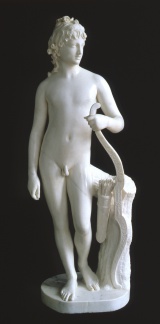 |
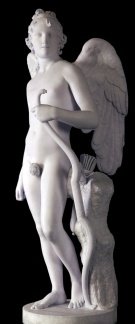 |
L’Amorino Lubomirski
La princesse maréchale Izabela Lubomirska (1736 – 1816) dut insister pour que Canova réalise un portrait de son protégé, le jeune prince Henryk Lubomirski. L’Amorino Lubomirski fut le premier essai de l’artiste dans cette forme particulière de portrait idéalisé, en personnage mythique, une solution qu’il déclina par la suite dans des portraits de femmes.[1]
Selon une source contemporaine, à cause de la timidité du petit prince qui refusa de poser nu, le portrait s’est limité au visage, et le corps serait inspiré d’exemples antiques [les citer]. Faut-il y voir un défaut dans son éducation rousseauiste, ou au contraire l’expression de sa nature ? Un esprit critique, Alexis von Krüdener (1744 – 1802), a regretté cette entorse à la synthèse néo-classique :
| Il rittrato, benchè estremamente armoniosio, non produce un bell’effetto perché è unito a un corpo di bellezza esemplare. Si puo dire che qui coesistano due linguaggie diversi e due verità l’una dall’altra differanziantesi.[2] | Le portrait, bien qu’extrêmement harmonieux, ne produit pas un bel effet parce qu’il est uni à un corps d’une beauté exemplaire. L’on peut dire qu’y coexistent deux languages différents, deux vérités différentes l’une de l’autre.
|
Ce devait être également l’avis de Canova qui, libéré de la contrainte du portrait, a cherché à résoudre ce problème pour ses trois commanditaires ultérieurs anglais, irlandais et russe. Chacune de ces trois autres versions est basée sur le plâtre original (acéphale depuis le bombardement de la gypsothèque de Possagno au cours de la première guerre mondiale).
Une animation en 3D se trouve sur le site du palais de Łańcut.
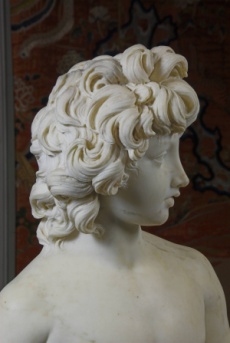 |
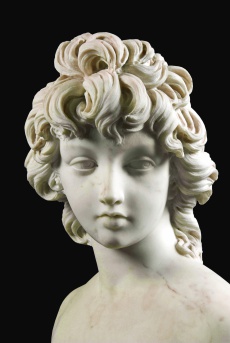 |
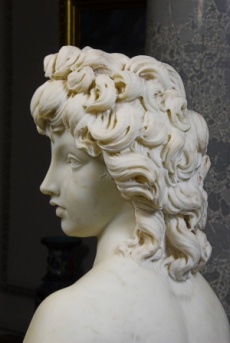 |
La commande date du printemps 1786.[3] « L’insistance importune de la princesse polonaise »[4] a eu raison des réticences de Canova à sculpter un portrait.
Il a commencé par modeler le visage en terre le 5 juin, puis a continué d’y travailler pendant dix-neuf jours. Le 2 juin, le plâtre était prêt. Le 4 juin, Canova achète à Carlo Albacini, pour la somme de vingt écus, une statue antique pour l’exécution de l’Amorino. Le marbre sera expédié à Łańcut en 1790.
En juin 1786, Canova, occupé aux statues du monument au pape Clément XIV pour l’église des Saints-Apôtres, fit une pause pour réaliser le modèle de l’Amorino Lubomirski.
A fronte d’ogni sua repugnanza per non aver mai fatto alcun ritratto, dovendo cedere finalmente all’importuna insistenza della principessa polacca Lobromiski, si mise a formare in creta il ritratto d’un leggiadro di lei nipotino di 12 anni, il signor principe Enrico Sartoriski ma per la timidezza sua naturale non pote compierlo se non che da se solo in assenza del giovinetto. Lo modello poscia in aprile sotto la figure intiera d’Amore. (Biblioteca Civica, Bassano del Grappa, manoscritti Canoviani, nr 6022 : Abbozzo di biografia 1804-1805, k.12 vol. (1787), Edizione nazionale, 1994, p. 304 ; Honour, 1994, p. 131.)
‘Adesso (sto?) lavorando o, per meglio dire terminando due Amorini, di grandezza all’età di (dice?) anni uno con la testa ritratto di un Sig.no nepote della Principessa Lubomirski di Varsavia […]’ (Biblioteca Civica, Bassano del Grappa, Manoscritti Canoviani, nr. H-8/6091 : Note di Antonio Canova sulle proprie opere, 1787, k. 1v-2, publié dans Edizione nazionale, 1994, p. 219 ; tez : Costamagna, di Macco, 1973, p. 223).
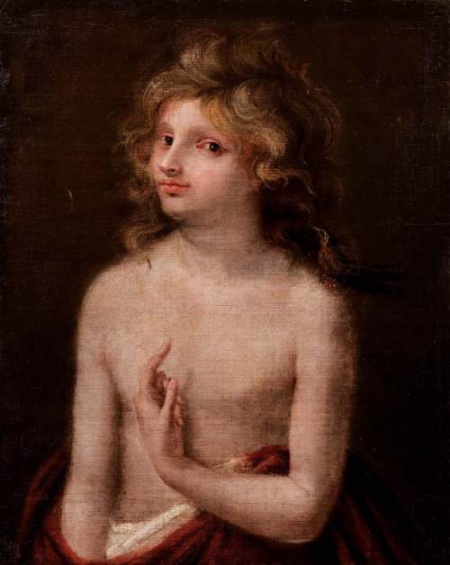
Portrait du prince Henryk Lubomirski en petit saint Jean
Huile sur toile, 67 × 53,5 cm
Collection privée
Cette esquisse peinte à l’huile est attribuée à Canova. Il est tentant à la fois de l’insérer dans le processus de création de l’Amorino Lubomirski, et de la faire correspondre à une mention dans la liste des œuvres de Canova (Mezza figura di fanciullo in atto di guardare un uccello). Elle était inédite en 2009.[5]
La princesse maréchale, en plus du marbre, avait demandé deux moulages en plâtre avec feuilles de vigne.[6] L’un d’eux, documenté à Łańcut à partir de 1802, fit partie de la donation de Henryk Lubomirski à l’Ossolineum ; il est retourné à Łańcut après la seconde guerre mondiale.
Trois autres œuvres dérivées sont connues en Pologne. Un buste, qui appartint à la princesse maréchale, une statue entière,[7] et une tête entrée vers 1789 dans la collection du roi Stanislas Auguste II Poniatowski.[8]
Au palais de Łańcut, la statue fut placée dans le cabinet aux colonnes, dans un décor spécialement remanié pour elle par l’architecte néo-classique Szymon Bogumił Zug (1733 – 1807). Un portrait peint du prince Henryk y ornait un trumeau, et fut remplacé par un miroir et un faux-relief en grisaille. Un dessin annoté témoigne de l’interaction entre l’architecte et une princesse très directive.[9]
[Commentaire d’Isabella Teotochi Albrizzi]
L’Amorino Campbell
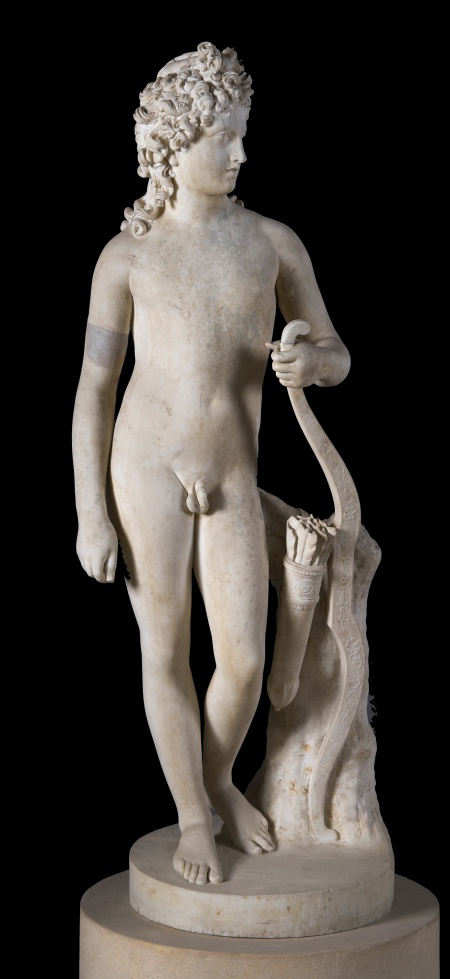
Abbaye d’Anglesey
Sculptée en 1788-1789 pour le colonel John Campbell, futur premier baron Cawdor (1755 – 1821), qui fut aussi le commanditaire (jamais livré) du groupe Psyché et Cupidon, aujourd’hui au musée du Louvre.
Canova n’était pas pleinement satisfait de la tête de ce second Amorino (une version inversée, et légèrement expressive, de la tête de l’Amour de Centocelle), et a proposé à John Campbell de lui en sculpter un autre, s’il parvenait à s’en débarrasser en le vendant au jeune John David La Touche. Des commentaires favorables étaient parvenus à Campbell ; il maintint sa commande et à l’arrivée de son Amorino à Londres en janvier 1791, se déclara ravi et paya à Canova la somme de cent sequins en plus des cinq cents convenus.
La commmande comprenait un piédestal en forme d’autel romain avec une plateforme tournante et un décor sculpté en relief avec des aigles qui suspendent des festons de fleurs dans des bordures de feuillage.[10]
Quatremère de Quincy a mentionné l’Amorino Campbell en 1834.[11]
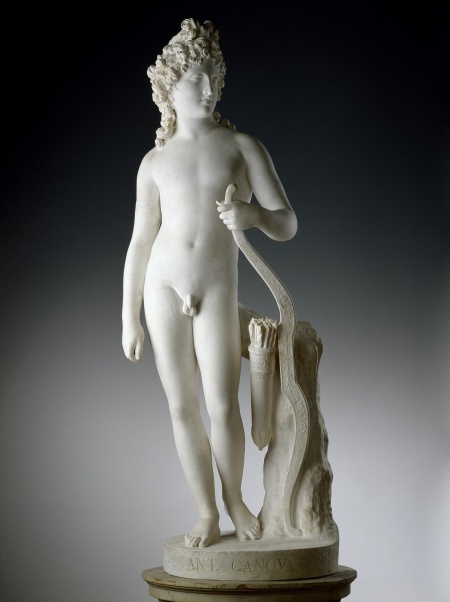
Un exemplaire en plâtre de cet Amorino était en 2013 la propriété de l’antiquaire milanais Carlo Orsi Antichità, qui l’a exposé en 2010 au Palais de Venise, à Rome, à l’occasion de la 7e Biennale Internationale de l’Antiquariat.[12]
L’Amorino La Touche
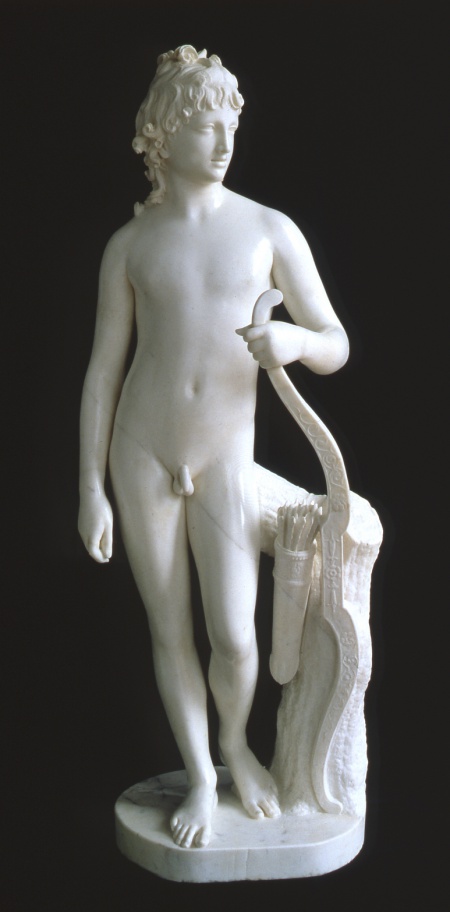
National Gallery of Ireland, Dublin
N° d’inventaire : Heritage Gift, Bank of Ireland, 1998 NGI.8358
Cet Amorino[13] fut redécouvert en mauvais état dans un jardin en 1996,[14] et acquis par la Galerie nationale d’Irlande à Dublin avec l’aide de la banque d’Irlande.
De passage à Rome en 1789, le jeune John David La Touche (1775 – 1820), fils du fondateur de la banque d’Irlande, en avait passé commande à Canova.[15] L’Amorino arriva à Dublin en août 1792.[16]
Le peintre irlandais Hugh Douglas Hamilton (?-?), ami de Canova, servit d’intermédiaire entre Canova et La Touche.[17][18]
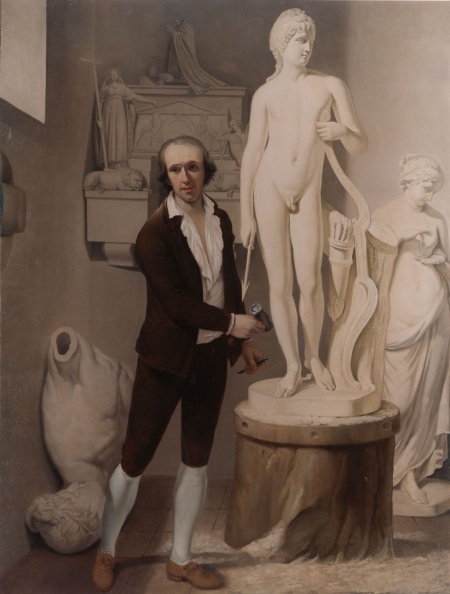
Portrait d’Antonio Canova sculptant l’Amorino La Touche
Vers 1793
Collection privée
Dans ce portrait d’Antonio Canova dans son atelier, l’Amorino La Touche tient une flèche, qui n’apparaît dans aucune des quatre variantes connues. Il cache en partie, à l’arrière-plan, le Génie de la Mort du modèle du tombeau de Clément XIII pour la basilique Saint-Pierre de Rome.[19]
Henry Moses (1782-1870) a donné une version gravée de l’Amorino La Touche pour illustrer le commentaire (1823) d’Isabella Albrizzi Teotochi.[20][21]
L’Amorino Youssoupov
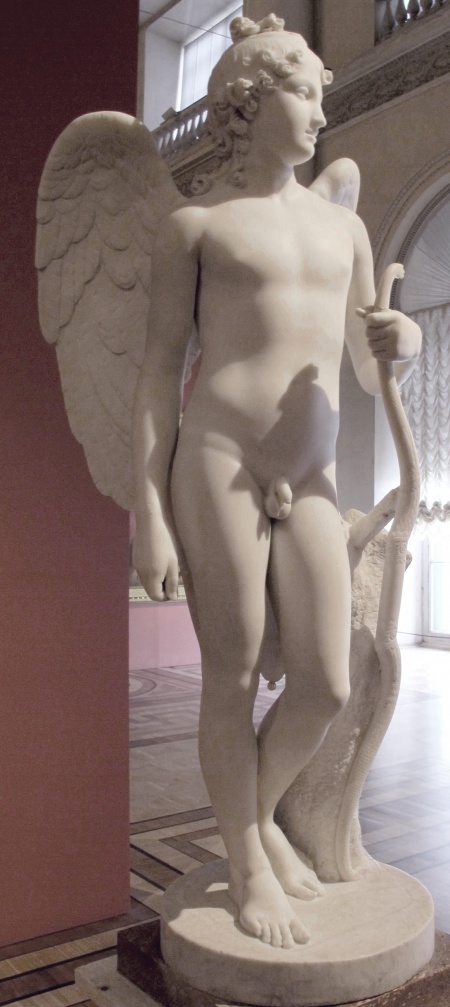
Musée de l’Ermitage, Saint-Pétersbourg
Selon Sergej Androsov, la commande aurait été passée en 1792 ou en 1793.[22]
Canova écrit le 13 novembre 1794 à Youssoupov : [« ... questa statua, che ha nuove ed eleganti forme, è la migliore di tutte quelle che io abbia mai fatto in questo genere. » (traduzione del francese)]
Lettre de Youssoupov à Canova, 15 décembre 1794 : L’Amorino, évalué à 700 sequins, devait être terminé pour le printemps 1795, mais l’envoi fut retardé, le paiement fut reporté, avant que les opérations militaires rendent les routes incertaines. L’Amorino arriva en juin ou en juillet 1802 à Saint-Pétersbourg en même temps que L’Amour et Psyché. D’abord placé dans palais Youssoupov sur la Fontanka, il fut transféré en 1810 à la résidence du prince Youssoupov à Arkangelsk. À la mort du prince en 1837, il fut placé dans un autre palais pétersbourgeois de la famille Youssoupov, et de là passa au musée de l’Hermitage en 1926.
Voir aussi
Bibliographie
Articles connexes
Notes et références
- ↑ Guilhem Scherf dans Portraits publics, portraits privés, 1770-1830, p. 38-39 et note 69.
- ↑ Francis Ley, Voyage en Italie du baron de Krüdener en 1786, Paris, Fischbacher, 1983, p. 129, cité dans Anna Coliva et Fernando Mazzocca, Canova e la Venere Vincitrice, Milano, Electa, 2007, ISBN 978-88-370-5589-9, p. 177.
- ↑ Lire Mario Guderzo dans Anna Coliva et Fernando Mazzocca, Canova e la Venere Vincitrice, Milano, Electa, 2007, ISBN 978-88-370-5589-9, p. 171.
- ↑ « Dovendo cedere finalmente all’importuna insistenza della principessa polacca Lobromiski (...) ». Livre de comptes d’Antonio Canova, cité par Mario Guderzo dans Anna Coliva et Fernando Mazzocca, Canova e la Venere Vincitrice, Milano, Electa, 2007, ISBN 978-88-370-5589-9, p. 171.
- ↑ Canova : l’ideale classico tra scultura e pittura, Forlì, Musei San Domenico, piazza Guido da Montefeltro, 25 gennaio – 21 giugno 2009 (Comitato scientifico presieduto da Antonio Paolucci. Mostra a cura di Fernando Mazzocca, Sergej Androsov).
- ↑ Italian American Magazine : culture and current affairs : rivista di attualita et cultura, « Antonio Canova, la bellezza nel marmo ». Article en ligne : Antonio Canova, la bellezza nel marmo
- ↑ Manikowska, 2002, n.XV.25, citée par Mario Guderzo dans Anna Coliva et Fernando Mazzocca, Canova e la Venere Vincitrice, Milano, Electa, 2007, ISBN 978-88-370-5589-9, p. 171.
- ↑ Correspondance entre Canova et le peintre Marcello Bacciarelli (Mikocka Rachubowa 2003, p. 24-25, citée par Mario Guderzo dans Anna Coliva et Fernando Mazzocca, Canova e la Venere Vincitrice, Milano, Electa, 2007, ISBN 978-88-370-5589-9, p. 171).
- ↑ Reproduit dans Majewska-Maszkowska, 1976, qui justifie : Gab. Ryc. BUW Inw. GR 232 — Zbiór Witke--Jeżewskiego 25. Fot. E. Kozłowska-Tomczyk. Un commentaire en anglais se trouve dans le résumé, p. 608.
- ↑ 84 cm (33 pouces) de haut. Ce socle a disparu entre 1937 et 1964.
The circular pedestal, which was ‘sculptured in relief with eagles suspending festoons of flowers within foliage borders, 33in. high’ (Christie’s 1937 sale catalogue description), and can be seen in a photograph taken of the sculpture when it was in the hall of Torry Hill, was still under the statue when this was sold by D. Leigh Pemberton at Christie’s on 22 July 1937 (lot 20), where it was bought by Mr. and the Hon. Mrs Basil Ionides, but was no longer so when Messrs. Crowther, who had bought the statue from Buxted Place after the death of Mrs Ionides, advertised it in Country Life, 3 December 1964, supplement p. 46 (quaere whether destroyed in the fire that ravaged the house in 1940?). Source http://www.nationaltrustcollections.org.uk/object/516599 - ↑ « L’Amour dont il est ici question fut le portrait du jeune prince Henri Czartorinski, pour la princesse Lubomirski. La tête du jeune homme étoit digne de devenir celle du fils de Vénus. Canova en fit depuis lors une répétition pour lord Cawdor. » (Quatremère de Quincy, Canova et ses ouvrages ou Mémoires historiques sur la vie et les travaux de ce célèbre artiste, Paris, Adrien Le Clere et Cie, 1834, p. 37.
- ↑ Retravailler cette référence : C. Orsi, 2007 - 55 pages
p. 25 et 49
In his letter to Canova of 5 July 1789 Zulian wrote: “Aveva inteso parlare dell’Amore fatto per un ritratto del figlio della principessa Lubomirski, ma non supeva della replica, che a voluto il colonel Campbell. Avrei desiderato, ma non avrei saputo pregarla del gesso, che cosi […].” - ↑ Sergio Benedetti, The La Touche Amorino: Canova and his fashionable Irish patrons, National Gallery of Ireland, nov. 1998, ISBN 0903162067
Hugh Honour, « Canova’s Amorini for John Campbell and John David La Touche », in : La scultura : studi in onore di Andrew S. Ciechanowiecki, Torino, 1994 (Antologia di belle arti, N.S. ; 48-51), p. 129, 139. - ↑ Alan Murdoch in Dublin, « Lost Canova’s return to glory », Monday 9 November 1998. En ligne : Lost Canova’s return to glory
- ↑ S. Benedetti, The La Touche Amorino, Dublin, 1998, p. 18-25, no. 1.
- ↑ Hugh Douglas Hamilton assista au déballage de l’Amorino à la résidence des La Touche à Dublin, Harcourt Street, le 14 août 1792. Lire F. Cullen, ‘The Oil Paintings of Hugh Douglas Hamilton’, Walpole Society, vol. L, 1984, p. 169-170.
- ↑ Il fit plusieurs portraits de membres de la famille La Touche. Lire S. Benedetti, The La Touche Amorino, Dublin, 1998, p. 8, et W. G. Strickland, A dictionary of Irish artists, Dublin, London, 1913, vol. I, p. 441.
- ↑ The extent of Hamilton’s involvement with the La Touche family is evident by the large number of portraits he painted of family members (see S. Benedetti, The La Touche Amorino, Dublin, 1998, p. 8 and W. G. Strickland, A Dictionary of Irish Artists, Dublin and London, 1913, vol. I, p. 441). In fact, Hamilton had been well known to the La Touches since the mid-1760s: he is known to have painted three portraits of John David in oil (a full length portrait is in the collection of the Bank of Ireland); three pastel portraits (one of which is in the National Gallery of Ireland). From 1787 to 1793 La Touche returned to Italy and it was whilst he was in Rome that he sat to Hamilton. In 1789 he commissioned from Canova the Amorino (see S. Benedetti, The La Touche Amorino, Dublin, 1998, p. 18-25, no. 1.) which was finished in 1793. There can be little doubt that it was Hamilton who introduced La Touche to Canova. The relationship between the two men continued after their respective return to Ireland. Hamilton stayed for several days in August and September 1792 at La Touche’s house, Bellevue, in County Wicklow (see F. Cullen, ‘The Oil Paintings of Hugh Douglas Hamilton’, Walpole Society, vol. L, 1984, p. 170). On 14 August 1792 he was present at the unpacking of Canova’s Amorino at the La Touche home in Harcourt Street, Dublin (Ibid. pp. 169-70). A delay in payment to Canova provoked Hamilton in 1794 to describe John David La Touche as the most indecisive and distracted man of this world (Ibid. p. 170). Nevertheless, two years later they were still enjoying each other’s company as attested to by John David’s record in his diary on 21 May 1796, ‘I dined at Mr. Hamilton’s saw his pictures most exquisite… Miss H aimable (sic)’. Three days later he went again to see Hamilton’s paintings (see N. Figgis and B. Rooney, Irish Paintings in the National Gallery of Ireland, vol. 1, National Gallery of Ireland 2001, p. 186, n.106; information supplied by Anne Crookshank and the Knight of Glin; Dublin, NLI, Pos 6016, Diary of John David La Touche 15 July 1794-29 August 1796).
- ↑ Lire la notice de Hugh Honour pour la galerie Lane Fine Art (lu en 2013) : http://www.lanefineart.com/index.php/component/virtuemart/shop.product_details/8/flypage.tpl/178.html
- ↑ Opere di scultura e di plastica di Antonio Canova descritte da Isabella Albrizzi nata Teotochi, Pisa, presso Niccolo Capurro,co caratteri di F. Didot, 1823, T.III, pl.92, n° XCII, pp.50-53. Il en existe une traduction anglaise de 1828 : The Works of Antonio Canova in Sculpture and Modelling , Engraved in Outline by Henry Moses; With Descriptions from the Italian of the Countess Albrizzi, and a Biographical Memoir by Count Cigognara, vol.III, London, Printed for Septimus Prowett, 1828, dont suivent les textes italien et anglais. Le traducteur a « moralisé » cette description au vocabulaire passionnel :
E qual v’ebbe mai pittore, o scultore, o poeta, che fosse d’animo alquanto soave e gentile, il quale non dipingesse, o scolpisse, o cantasse Amore; quel pargoletto Nume, di cui con gran senno fu detto, che ciascheduno, se non gli ha già tribulato, o non gli trubuta, sarà per tribulargli omaggio ? In questa figurina, che si bene arieggia il vezzoso figlio di Venere, non sai, se tu debba più ammirare il disegno, le forme, e la purità dell’attitudine, o la grazia, e quella squisita mollezza di tocco, ch’è pregio si grande, e si mirabile della Scultura. Sembra particolaramente che nelle labbra alquanto tumidette, e con amabile soavità dilatate verso le estemità, colpo non desse il gentile Scultore, che non partisse dirittamente dall’animo appassionato. Nel mirarti, ed admirarti, o vezzoso fanciullo, che con si bella leggiadria te ne stai, bellissimo di volto, e di membra, io sento correre con rapido movimento spinta dal cuore la mano a careggiare quel tuo vago, e dilicatissimo visetto, modellato dalle Grazie. E quanta venustà non danno al tuo volto medesimo, e quanta non ne ricevono i capelli, che da un semplice strofio sostenuti, e in una grande quantità di piccole regolari masse distinti, lievemente ondeggianti, contornano la giovinetta tua fronte, cadono sopra il tuo collo, e si stendono fino alla punta degli omeri ! Questo amabilissimo compagno delle Grazie ha l’ali al tergo, e leggermente s’appoggia con la sinistra mano sopra un grande arco. La faretra si vede appesa a quel tronco medesimo, che serve di appoggio all sinistra coscia, e fa sostegno a tutta l’agile personcina. Il piede diritto posa tutto in terra : del sinistro, non già per indizio di moto, mar per semplice vezzo di mossa, la punta sola. La sua picciola testa è volta un cotal poco a sinistra, e il destro braccio cade disteso sopra l’anca, mentre le dita della mano stanno con grazia infantile ripiega sopra sè stesso. Bellissimo è il corpicciuolo, e un’acerba fanciulezza traspare dalle ben composte sua membra. L’appogiarsi, ch’ei fa con una mano sopra il grand’arco, il braccio, che tiene abbandonato sull’anca, la faretra, che pende dal tronco vicino, quasi inutile arnese, quel piede, che posa fermo in terra, e sopra tutto la lieta, e serena aria del volto, in cui (meraviglia a dirsi d’Amore !) ombra di desiderio non ispunta; tutto sembra avvertirci del sentimento, che l’Autore ha voluto esprimere. Egli ha voluto rappresentarci Amore in quel breve, ma fortunato istante di compiacenza, e di soddisfazione, in cui pago, e contento dell’ultimo dardo, che ha scoccato, non pensa più nè a saettar, nè a volare. Ah ! l’espresse forse quale il bramava con caldo secreto voto l’appassiono Scultore.
Poet, sculptor, or painter, has rarely been found insensible to the fascinations of this young deity, or neglectful in doing homage to him by his peculiar art. In this image of the charming son of Venus, the beauty and purity of design, and that exquisite delicacy of touch which is the highest effort of sculpture, and produces its most enchanting effect, are equally to be admired; his gentle form and limbs possess that early and unformed beauty which is proper to his age; his luxuriant locks are divided into short curls, and fall down behind to the point of his shoulders, giving a soft lustre to his beautiful countenance; and in forming the lips, which are somewhat full and dilated at the extremities, with an expression of great sweetness, the sculptor’s hand seems to have been guided by the most empassioned feelings; he is standing in an easy and graceful attitude beside the trunk of a tree, on which he has hung his quiver; in his left hand he holds his irresistible bow, and the other, falling down on his side, rests on his hip, with a charming expression of youthful grace; his calm and reposing posture, his bow unstrung, and quiver laid aside, and above all, the gentle and serene expression of his features, in which no threatened mischief lies, all indicate that the sculptor would here express that tranquil and delightful state when love, viewing with complacency the effect of his last shaft, permits to his votary a delightful interval of constancy and repose. - ↑ Son portrait (1792) par Elisabeth Vigée-Lebrun est conservé au Toledo Museum of Art, Ohio.
- ↑ Sergej Androsov, dans Anna Coliva et Fernando Mazzocca Milano, Canova e la Venere Vincitrice, Electa, 2007, ISBN 978-88-370-5589-9, p. 177.